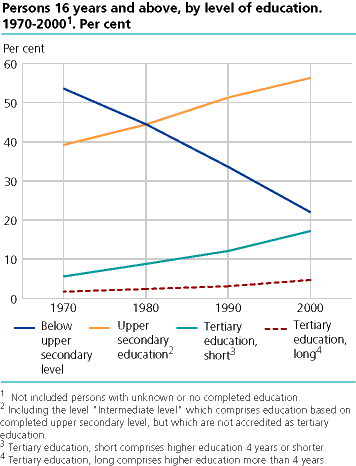Content
Published:
This is an archived release.
Rise in level of education since 1970
Compared with 1970, three times as many Norwegians have completed some form of tertiary education. The figures were doubled from 1980 to 2000. The number of inhabitants with a level of education below upper secondary has more than halved since 1970.
In 1970 more than half of Norway's population above 16 years old had only completed education below upper secondary. In the autumn of 2000 the proportion were only 22 per cent.
Every fifth inhabitant has completed some form of tertiary education, as compared with 1980 where every tenth completed. Persons with unknown or no completed education are not included in these calculations. The increase in the number of persons with tertiary education might be viewed in light of the increase in admission capacity at Norwegian institutions of higher learning from the late 1980s to the early 1990s. A high rate of unemployment in the late 1980s, along with increased public interest in people with specialised expertise might also be of importance.
Most women with short higher education, most men with longer education
The proportion of women with short tertiary education is larger than the proportion of men. Nearly 20 per cent of women between 20 to 24 years old have completed short tertiary education, compared with about 10 per cent of the men in the same age group. That amounts to more than 75 000 more women than men with a short higher education. On the other hand, more men than women have a long tertiary education. To be more exact, more than 61 000 more men than women have completed a long higher education. For instance, nine per cent of the men between 50 to 59 years old have a long tertiary education, compared with only three per cent of the women in that age group.
Gender differences
At all levels of education, most men have completed an education with focus on the natural sciences. There is a female majority within education and teachers training, health, and general subjects. However, most women with some form of long tertiary education have, like the men studied natural sciences.
Highest level of education in Oslo
Oslo and Akershus are the counties with the largest proportion of inhabitants with a tertiary education. Hedmark and Oppland have the least proportion. Bærum, Asker, Oslo, Nesodden and Ås are the municipalities with the largest proportion of inhabitants with tertiary education. At the opposite end of the scale we find Værøy, Torsken, Beiarn, Karlsøy, and Osen. Nevertheless, it is important to mention that Oslo and Akershus also have the largest majority of persons with unknown or no completed education, and they are not included in these figures.
Tables:
- Table 1 Persons 16 years and above, by level of education and county of residence. 1. October 2000
- Table 2 Persons 16 years and above by level of education and municipality of residence. 1. October 2000
- Table 3 Persons 16 years and above by highest completed education, gender and age. 1. October 2000. Per cent
- Table 4 Persons 16 years and above by highest completed education (gender and area of study). 1. October 2000
Contact
-
Andrine Stengrundet
E-mail: andrine.stengrundet@ssb.no
tel.: (+47) 95 48 60 28
-
Anne Marie Rustad Holseter
E-mail: anne.marie.rustad.holseter@ssb.no
tel.: (+47) 93 45 98 35
-
Maj-Lisa Lervåg
E-mail: maj-lisa.lervag@ssb.no
tel.: (+47) 45 68 84 72

